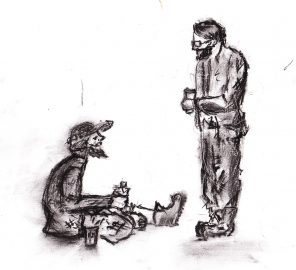The “Fake” Struggle is Real
By Adina Pernell
Apparently appropriation is the new fashion equivalent of the little black dress, and trends of cultural and socio-economic appropriation are currently undergoing a renaissance.
Style choices like Bo Derek’s 1979 cornrows have kept cultural appropriation in fashion for decades. In recent years, fashion designer Marc Jacobs has become something of a poster boy for it.
For his upcoming Spring 2017 season fashion show, he took a centuries-old African tradition of braiding accessories like yarn, shells and beads into hair, and debuted it as his own on Sept. 15.
African American celebrities like George Clinton of the funk group Parliament and Funkadelic have been incorporating beadwork and shellwork into their image for years as a symbol of cultural pride.
Earlier in the year, fashion house Balenciaga was subject to sarcasm and ridicule by the people of Thailand for taking the sampheng, a Thai bag traditionally used as a cheap laundry bag, and marketing it as something unique to their vision.

Surely the idea of what constitutes fashion is subject to the wearer and the viewer, but when is enough enough? Where is the line drawn when it comes to appropriation?
If Marc Jacobs were to introduce, say, Balenciaga’s culturally and economically appropriated bags in shows as his own designs, he would be laughed out of Fashion Week, probably never invited to return and lose a great deal of his industry credibility.
So let me get this straight: In the fashion industry it’s totally okay to copy entire cultures or socio-economic groups and not even credit them for providing the raw material for your artistic inspiration, but it is completely taboo to copy another fashion designer’s ideas.
This feels very much like a form of fashion plagiarism. Plagiarism in any creative community is an ugly word; in fact, it might very well be the artistic equivalent of a four letter word.
Yet, it’s happening with growing frequency under the umbrella of appropriation. I tie in the fashion industry because they not only normalized but fostered many trends by making appropriation cool.
The 2013 Vice article “Rich People Who Pretend to Be Poor Are Obnoxious”
by Carly Lewis drew attention to the rise of slumming it and being shabby chic. According to Lewis, popular clothing chain Urban Outfitters calls its target demographic “upscale homeless.”
Maybe those who adopt an impoverished lifestyle when their checkbook is in the triple zeros are so desperate to feel “normal” that they manufacture an illusion of income deficit.
Just visit any urban city and you will see them: the faux poor.
Do I blame Brad Pitt and Leonardo Dicaprio’s carefully manufactured scruffy look for spawning a generation of hipsters who would rather looked distressed then actually be distressed?
Or should I lay blame at the feet of gentrification heros who seeks to glorify poverty as an experience they can shed as easily as last year’s fashion nightmare?
The impact that gentrification has on low-income communities can be seen in everything from trend-seekers buying into disadvantaged communities, raising prices of rent, to trust fund babies raiding Goodwills and driving up clothing prices for individuals who have a legitimate need to shop there.
These are the same people who think it noble to “live poor” for a month as a life experience when they have the luxury of returning to $5000 a month apartments in the SOMA district, while a host of low-income dwellers struggle in the Tenderloin and homelessness explodes to new heights beneath overpasses.
Their quest might be better served if they embraced their privileged realities and used some of their influence to create better experiences for underprivileged communities, rather than momentarily live by a statement that romanticizes a painful circumstance affecting the health of millions of people.
Instead of embracing the low-income plight, faux poor attitudes are creating a climate ripe for an even greater socioeconomic divide by defining poverty as a lifestyle choice and not as an age-old problem of social class.
